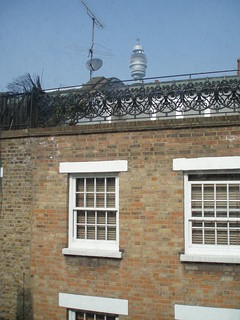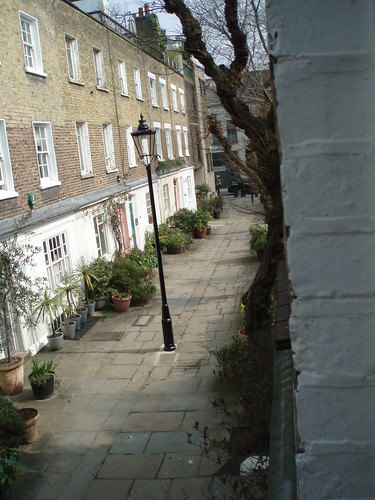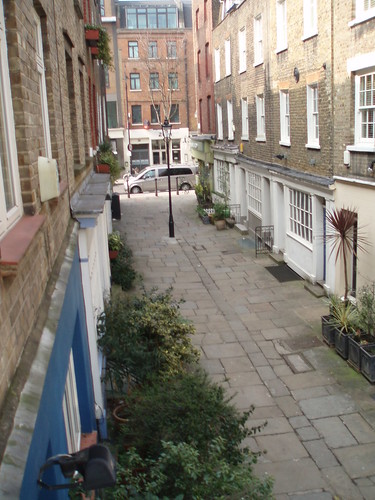 |
| View from the top floor. My great grand uncle would not have seen the BT Tower, of course! |
- Susan Wilkes in the Black Country (a distant cousin of Margaret’s) gave me useful information about the Robinsons and also passed on the story of family members killed at Pelsall Colliery when the pit was flooded by water from older mine workings.
- Simon in Florida contacted me. We’re related somehow, but not sure exactly how. He’d traced his family back to Great Budworth in Cheshire and had been so touched to see a plaque on one of the buildings there saying it has been Rayner’s tailor’s shop. I was only the second living Rayner he’d come across. We shared the frustration of the different interpretations of the surname across the years - Raynor, Rainer, Rainow ... it’s a long list of clerks, clergy and census compilers who can’t spell Rayner (or perhaps it was the Rayners who couldn’t spell?).
- My cousin Jennifer’s husband Mike has done much good research which he’s shared with me, helping to unravel some mysteries about Richard Gibson Little, my grandfather. We’ve spent some interesting time speculating about illegitimate children and parentage.
- I had a nice note from Graham Evans in Canada who contacted me about our common Mitchell ancestors from Hales and Stockton in Norfolk. Their family had an oral account of life on the farms; the hard work, but their happy lives and their can-do attitude.
- Best of all was a communication with a distant cousin Ann Seymour in America who was a relative of Zachariah Burrows (my 2x great grand uncle). With their help I was able to trace his journey from Burston in Norfolk to Clearwater in Upper Canada and on to the pioneers of the new state of Nebraska. Ann also sent me a copy of a letter written by Ann Burrows, my 3x great grandmother, in 1843 to her son in Canada.
There have been lots of other discoveries, many tinged with sadness, like the story of Margaret’s dad’s first wife, who died from septicemia after pricking her finger on a rose thorn (thank goodness for penicillin these days), children in workhouses and orphanages and even a family member surviving five years in Dachau concentration camp.
What’s also been nice (and I plan to do much more of this when I retire) is to actually visit places. There’s something wonderful to be able to tread in the footprints of your ancestors, it gives you a terrific feeling of connection. It’s not always easy to do that; houses are demolished, roads and housing estates built and land uses change beyond recognition. The Liverpool of my great grandparents was largely obliterated by German bombs during the Second World War and what Hitler started the town planners and developers of the 1960s and since have finished off. In rural communities like Norfolk, it is even harder. Often the village would not have house numbers or even street names. The early census returns just showed everyone who lived there. In Stockton, my ancestors were listed as living “in the woods” (which makes them sound like elves) and later in one census as “Stone Cover Woods”. Wandering around the parish of Stockton, I came across the Stockton Stone and realised that they would have lived in Stone Covert (with a T) Wood, which helped me place them.
As my ancestors left the countryside and moved to the city, I was able to trace a couple of people to locations in London, including Harry Mitchell, my great-grandfather's younger brother, who in 1901 was living with his uncle, cousins and three lodgers in Colville Place off Charlotte Street (now very fashionable Fitzrovia) but in those days described as the Parish of St Pancras and a much more cosmopolitan area. I wrote about this in my blog Visiting the Past.
I thought that was that, but a few weeks ago I got an e-mail from the new owner of the house to say that he’d read my blog and would I like to have a look around. He’d been researching the history of the house had searched the address and found my posting. We both share an interest in our history and the history of places, so he was able to tell me a little more about the place. It was built in the 18th century, so is well over 200 years old and it was bomb damaged during the Second World War, which is what I suspected because there’s a little park next to it and the end gable contains the remains of a fireplace of what would have been in the house next door.
The owner knew that it had been extensively damaged and repaired and because of this it was not listed, like other houses in the street, but was in a conservation area, so he was having to seek planning permission for a variety of work, including replacing the old Crittall steel windows (certainly not an original feature) and replacing them with a Georgian style more in keeping with the Regency period when the house was built.
The house had been occupied by an old lady and so needs quite a lot of work doing to it. Rooms have been knocked through, but the layout would be largely the same as when my ancestors lived there over a hundred years ago. There’s a cellar, ground floor, first floor and second floor, so four storeys in all, which are connected by a steep and winding staircase (quite tricky to negotiate until you are used to it). I was surprised by how slim the house is. Once you’re through the front door, you’re more or less at the back, but it is lovely and light inside. The new owner will live there with his wife and it will make a lovely spacious house for two people or a small family. My great uncle shared it with an uncle and an aunt, two cousins and three lodgers (a waiter, a hotel worker and a musician). It must have been quite tight at times, even saying people didn’t have as many clothes or possessions in those days.
At the back is a large brick and slate outhouse. All the houses had them, but some have been demolished and some converted into garden rooms. The owner wondered if it might have been a workshop for my plumbing ancestors and they may well have used it for that purpose. The uncle was listed as working on his own account (self-employed) and from home. Also, it's not unlike the wash-house and toilet of the house in Manchester Road, Lostock Gralam, where I grew up.
 |
| Inside the outbuilding at the back of the house. |
It’s interesting that a property that was once a relatively modest home and high-density living is now a really fashionable and desirable part of London. The view from the windows that I had would have been quite similar, but also quite different for my ancestors - much more smokey for a start and they definitely wouldn’t have been able to see the BT Tower poking its head above the rooftops opposite.
In my previous posting, I reported the house had been advertised for sale at £1.8 million. The new owner was keen to tell me that he hadn't paid that much for it. I said he was interested in the history of places, so he may well discover more about Colville Place. He told me that his current home (in Primrose Hill) was the place where the first 999 emergency call was made from. The occupier had seen a man climbing over a fence and suspected a burglary. There's an interesting piece on the 999 service in Wikipedia.
In my previous posting, I reported the house had been advertised for sale at £1.8 million. The new owner was keen to tell me that he hadn't paid that much for it. I said he was interested in the history of places, so he may well discover more about Colville Place. He told me that his current home (in Primrose Hill) was the place where the first 999 emergency call was made from. The occupier had seen a man climbing over a fence and suspected a burglary. There's an interesting piece on the 999 service in Wikipedia.
 |
| Above and below: views along Colville Place from the first floor of no 18. |



No comments:
Post a Comment